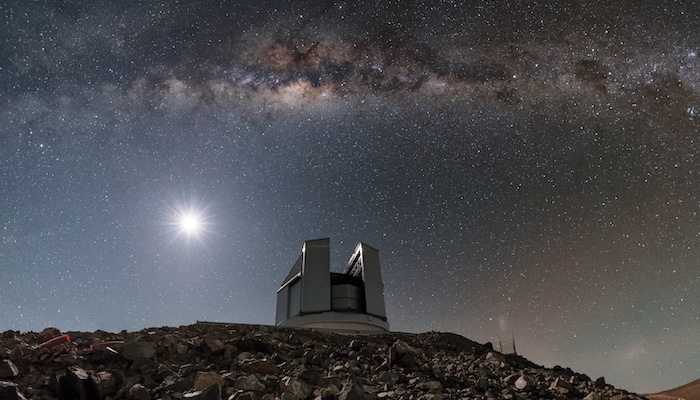Media release
From:
An astronomical instrument featuring Australian-built technology has achieved first light – the crucial moment when a telescope captures its first images – at the European Southern Observatory’s Paranal Observatory in Chile.
The 4MOST (4-metre Multi-Object Spectroscopic Telescope) facility uses an optical fibre positioning system built by Macquarie University’s Australian Astronomical Optics (AAO), allowing the telescope to simultaneously observe thousands of celestial objects, from stars and planets to nebulae and black holes.
At the heart of 4MOST sits AESOP (Australian-European Southern Observatory Positioner), the robotic fibre positioning system designed and built by AAO. AESOP can position 2438 optical fibres with 10-micron accuracy (about 0.01 millimetres, or one-seventh the width of a human hair) in under one minute. Each fibre captures light from a different star, galaxy or other celestial object, feeding it to spectrographs that analyse the light in detail.
Precision robotics breakthrough
The technology represents an evolution from AAO’s pioneering 2dF (2-degree Field) system developed in the 1980s, which transformed multi-fibre spectroscopy from a novelty into a productive astronomical technique.
Where 2dF could capture 400 spectra at once, AESOP handles more than 2400 simultaneously.
“AESOP is a major leap in precision robotics, delivering higher accuracy, tighter actuator density and faster configuration times than any previous fibre positioning system,” says Distinguished Professor Jon Lawrence, head of instrumentation at AAO.
AESOP’s journey from concept to first light spanned 15 years. The AAO team delivered the system to Potsdam, Germany in 2021, where it was integrated with the broader 4MOST instrument before installation on the VISTA telescope in Chile.
Key team members involved in the historic installation included Helen McGregor, AAO’s mechanical group manager; Scott Smedley, the AESOP project manager; Slavko Mali, electronics technician; and Dylan Simpfendorfer, junior mechanical engineer.
The project brought together a consortium of 30 universities and research institutes across Europe and Australia, led by the Leibniz Institute for Astrophysics Potsdam. The 4MOST science team includes more than 700 investigators worldwide.
“It is a true international collaboration and a proud milestone for the team,” says Professor Lawrence. “The 4MOST project cements AAO’s reputation as a world leader in astronomical instrumentation.”
First observations demonstrate versatility
First light demonstrated a key advantage of 4MOST: the ability to observe a large field of view while investigating numerous different objects and science cases simultaneously in detail.
During its first observations, 4MOST captured the Sculptor Galaxy (NGC 253), located 11.5 million light years away with one of the largest apparent diameters in the southern sky. In just 20 minutes, 4MOST also obtained spectra of more than 2000 other objects, from nearby Milky Way stars to galaxies up to 10 billion light years distant.
Professor Daniel Zucker, professor of astronomy and astrophysics at Macquarie University’s School of Mathematical and Physical Sciences, tuned in via Zoom together with thousands of other astronomers to watch the first images come through from 4MOST.
“It was exciting seeing the first data from stars, galaxies and distant quasars coming in, after so many years of effort by hundreds of people around the world, including the amazing work done by the AAO team in Australia, without which this whole project would not have been possible,” he says.
Understanding through spectra
While many telescopes simply photograph the sky, 4MOST breaks down the light from each object into its component colours – a spectrum – revealing information invisible in ordinary images.
“Astronomy has entered an era of big data, where massive surveys are mapping the skies, detecting billions of objects,” says Professor Zucker.
“But to truly understand the nature of these objects – whether they be stars, galaxies, quasars or some entirely new astrophysical phenomenon – we need spectra.”
Astronomical spectra work like cosmic fingerprints, revealing what an object is made of, how hot it is and how fast it is moving through space.
Over the next 15 years, 4MOST will conduct 25 science programs investigating topics such as the origin of chemical elements, the formation of the first stars, the nature of dark matter and dark energy, and the evolution of galaxies and black holes.
Thanks to AESOP’s multi-fibre system, many different programs will run simultaneously – for example, several fibres can study rare objects for one program, while another uses most other fibres to create large statistical samples of stars or galaxies.
“(The location of) 4MOST … in the southern hemisphere enables tremendous synergies with other major astronomical facilities,” says Professor Zucker, adding these collaborations mean astronomers can combine data from other telescopes to learn much more than they would from one on its own.
As Professor Lawrence explains, the precision engineering behind AESOP potentially has applications beyond astronomy.
“The combination of precision mechatronics, compact design, and scalable control makes AESOP’s technology highly transferable to industry applications such as medical robotics, aerospace, and precision manufacturing – and AAO is actively exploring these pathways,” he says.



 Australia; VIC
Australia; VIC


